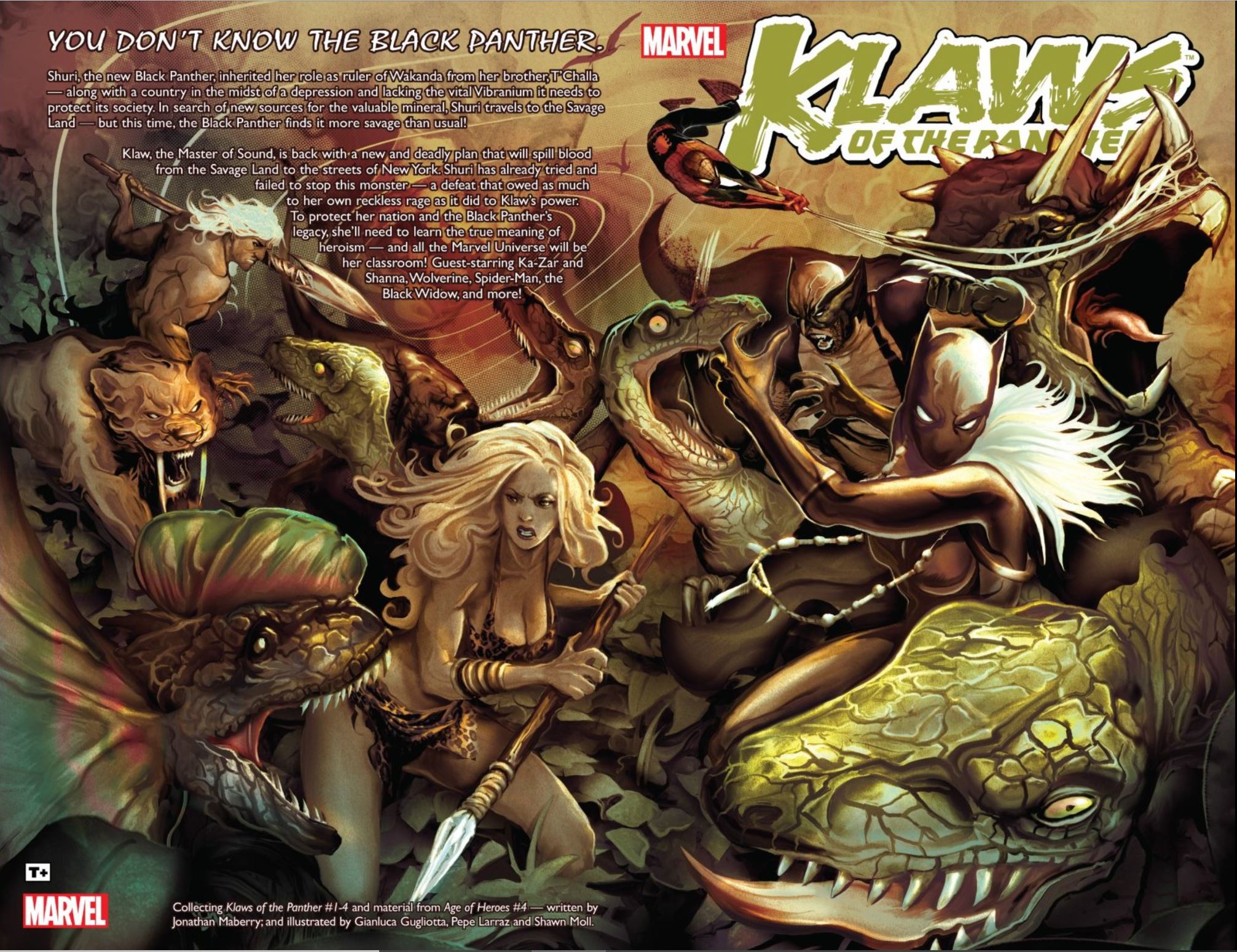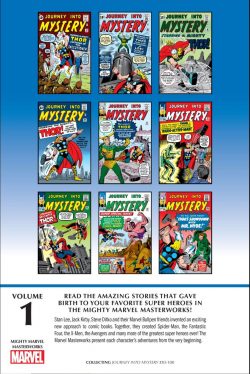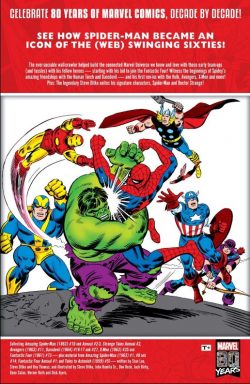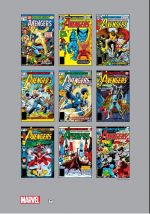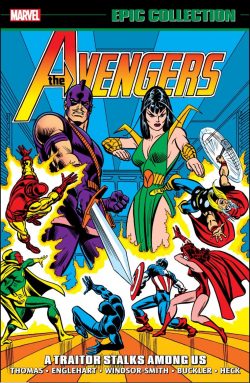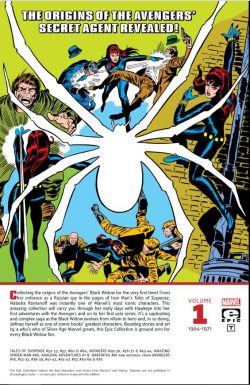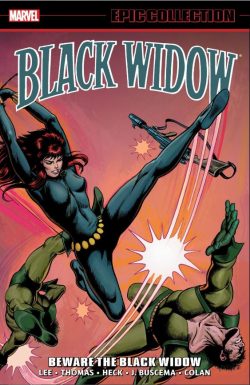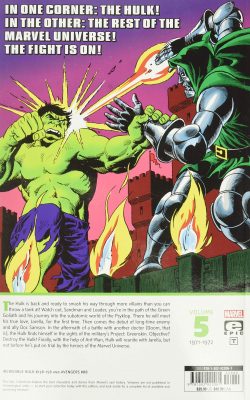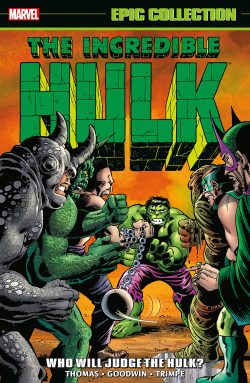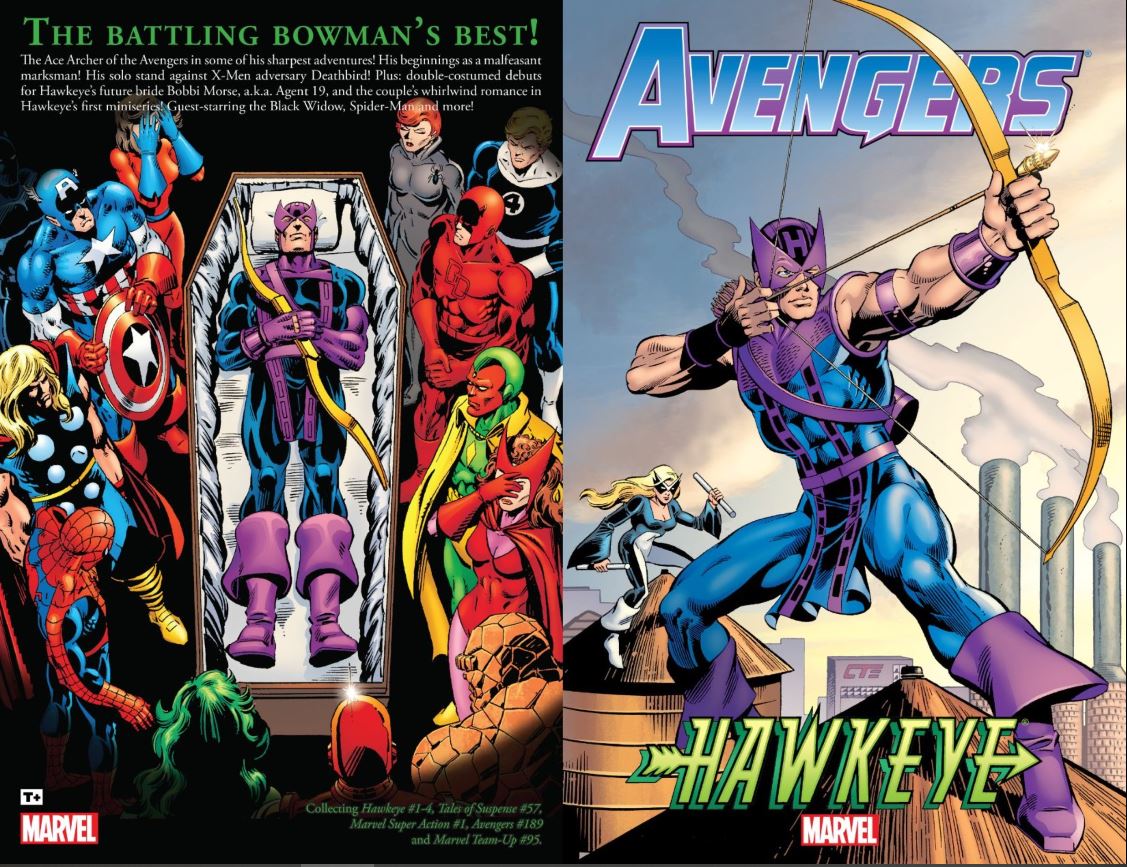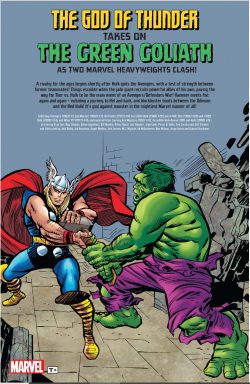

By Stan Lee, Jack Kirby, Roy Thomas, Steve Englehart,Bill Mantlo, Peter David, Erik Larsen, Jeph Loeb, Jeff Parker, Peter B. Gillis, Jim Shooter, Sal Buscema, M.C. Wyman, Angel Medina, Jorge Lucas, Ed McGuinness, Gabriel Hardman & Ron Wilson & various (Marvel)
ISBN: 978-0-7851-8515-4 (TPB/Digital edition)
It bears repeating: on an inescapable primal level, comic books are all about one question; “who’s strongest/who would win if…?
The Incredible Hulk and Mighty Thor share their 60th anniversary this year, and whether in print, in animations or in blockbuster movies, that eternal question has been asked but never answered to anyone’s satisfaction whenever applied to the modern iteration of the age-old mythic war between gods and monsters.
Packed with potent past clashes from the very start, this titanic tome opens with an erudite Introduction from former editor Ralph Macchio (no, the other one) outlining the concussive delights that follow. Contained herein are bouts and sagas first seen in Avengers #3; Journey into Mystery #112; Sub-Mariner #35; Defenders #10; Incredible Hulk #255, 440; Thor #385, 489; Incredible Hulk Annual 2001; Hulk (2008) #5-6, 26; and What If? #45, spanning cover-dates January 1964 – December 2010, but there’s no time for nonsense or niceties as the action opens at full throttle with Stan Lee, Jack Kirby & Paul Reinman revealing how in Avengers #3 ‘The Avengers Meet… Sub-Mariner!’
The previous issue saw latent animosities between Iron Man, Giant-Man, Wasp, and Thor lead to the aggressively volatile Hulk quitting the team in disgust. He returned as an outright villain in partnership with the vengeful prince of devastated Atlantis in a globe-trotting romp delivering high-energy thrills and one of the best battle scenes in comics history as the assorted titans clashed in abandoned World War II tunnels beneath the Rock of Gibraltar. Naturally, there was no clear winner when Thunderer and Gamma Goliath briefly battled…
The true birth of this particular grudge match came via a potent flashback in Journey into Mystery #112 (January 1965) which gave the readers what they had been clamouring for with ‘The Mighty Thor Battles the Incredible Hulk!’: a glorious gift to all those fans who perpetually asking the question “who’s stronger…?â€
Possibly Kirby & Chic Stone’s finest artistic moment, it detailed a private duel between the two super-humans appearing off-camera during the free-for-all between The Avengers, Sub-Mariner and the Jade Juggernaut.
Jumping to a new decade, we see the solitary green gargantuan reconsidering his position on teamwork as a 2-part tale heralded the formation of a new supergroup. The Defenders’ story officially begins with Sub-Mariner #34-35 (February & March 1971: with only the latter included here).
The Prince of Atlantis was an early advocate of the ecology movement, and here (rather fractiously) recruited Hulk and The Silver Surfer to help him destroy an American nuclear weather-control station. Concluding in ‘Confrontation’ (by Roy Thomas, Sal Buscema & Jim Mooney) the misunderstood trio battled a despotic dictator’s forces, the US Army, UN defence forces and the mighty Avengers to prevent the malfunctioning station from accidentally vaporising half the planet, offering the emerald berserker another shot at that long-haired upstart who claimed to be the strongest one there is…
When the Defenders formed, their clandestine nature and line up (avowed antisocial menaces Sub-Mariner, Hulk, Valkyrie and enigmatic Doctor Strange) allowed mystic villains Loki and Dormammu to foment a war between the non-team and The Avengers that became a classic crossover event when that was a rare thing…
It lead to ‘Breakthrough! in Defenders #10 (November 1973) as Steve Englehart, Sal Buscema & Frank Bolle lavished many pages on epic standoff ‘The Incredible Hulk Vs. Thor’ before the inevitable joining together of warring camps in ‘United We Stand!’ That’s a great story you will need to seek out elsewhere as here we’re all about the bash… no trouble…
Courtesy of Bill Mantlo & Sal B, Incredible Hulk #255 (January 1980) detailed Thunder Under the East River!’ as reasons for the inescapable rumble become harder to manufacture. Here, the monster’s meanderings in New York and innate simmering belligerence are sufficient to spark off another blockbusting brouhaha while Thor #385 (November 1987) saw Jim Shooter provide a plot for Stan Lee to script, while Erik Larsen & Vince Colletta handled all the bellicose pictorial breakages in another city-set smash-up in ‘Be Thou God or Monster!’
After Image Comics’ debut compelled the Big Two (that would be DC and Marvel) to chase their deconstructivist, edgy style in the mid-1990s, radically reimagined Hulk and Thor bouts took on added grit and grimness. The changes were first seen in Thor #489’s ‘Hel and High Water’ (August 1995 by Thomas, M. C. Wyman & Mike DeCarlo) as a Hulk with Banner’s intellect rescued the Thunderer from beyond Death’s grasp, yet still ended up trading blows, whilst Incredible Hulk #440 (April 1996) featured Peter David, Angel Medina & Robin Riggs’ ‘The Big Bang’ as Thor strove against evil Future Hulk The Maestro with the world at stake and the lethal Leader pulling the strings…
Harking back to glory days, Incredible Hulk Annual 2001 (by Larsen, Jorge Lucas, Al Milgrom, Al Vey & Greg Adams) pastiched and homaged classic Kirby Kaos in ‘The Hammer Strikes’ as Thor drags the Jade Juggernaut across time and space in an extended clash but finds nowhere where their struggle will not create carnage and catastrophe…
Years passed and it transpired that green was not the only gamma wavelength to bear bitter fruit…
Cover-dated October & November 2008 and crafted by Jeph Loeb, Ed McGuinness, Mark Farmer & Dexter Vines, Hulk (volume 2) #5-6 detailed a no-holds barred battle between Thunder God and a ruthless Red Hulk (AKA General Thaddeus “Thunderbolt†Ross) in ‘Rolling Thunder’ before concluding with ‘Blood Red’ with the original Green Goliath and Avengers stepping in stop the carnage. Hulk #26 (December 2010, by Jeff Parker & Gabriel Hardman) then provides a notional rematch as prelude to cosmic shenanigans in ‘Scorched Earth Part II’…
Wrapping up the furious fisticuffs is an out of chronology tale from What If? #45 (June 1984) by Peter B. Gillis, Ron Wilson, Ian Akin & Brian Garvey, wherein Banner’s worst nightmare came true in ‘What If the Hulk Went Berserk?!’ Set in the early months after the Gamma bomb mutated the scientist, it thrillingly details the alternate Earth deaths of most of the budding Marvel Universe before Thor even arrives…
Adding to the beefy brilliance is a range of Classic Battles’ as depicted by Frenz & Milgrom (from Incredible Hulk #393), Arthur Adams & Laura Martin (Avengers Classic #3), Kirby, Reinman & Paul Mounts (Avengers Epic Collection #1) and John Romita Sr. & Richard Isanove (Avengers/Defenders War TPB), and cover sketches for (Red) Hulk #6 by Ed McGuinness.
Vivid, vibrant and valiantly irresistibly vicarious, these fabulous forays are primal yet perfect examples of superhero stories’ Prime Directive and deliver all the pictorial punch and panache any Fights ‘n’ Tights fiend could hope for.
© 2017 Marvel Characters, Inc. All rights reserved

